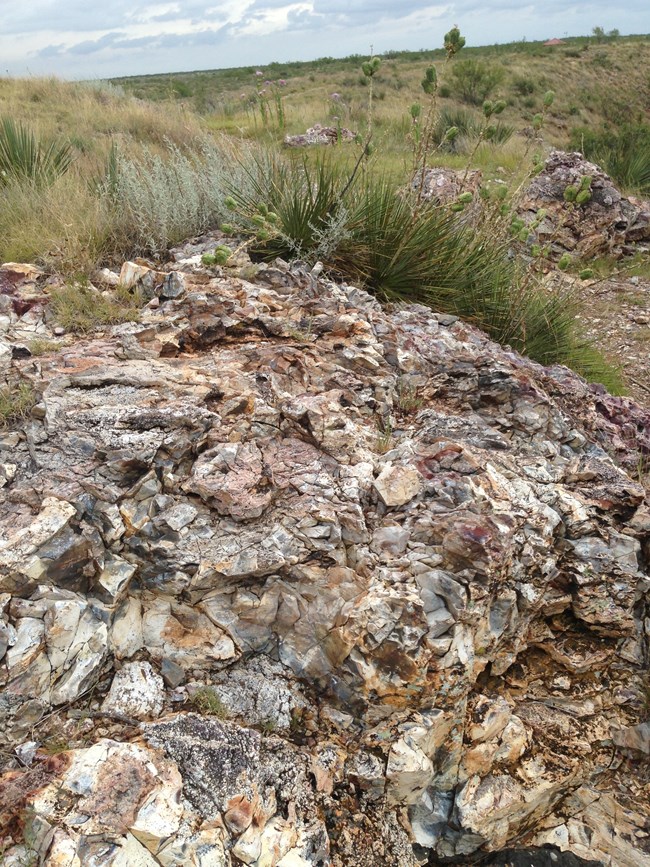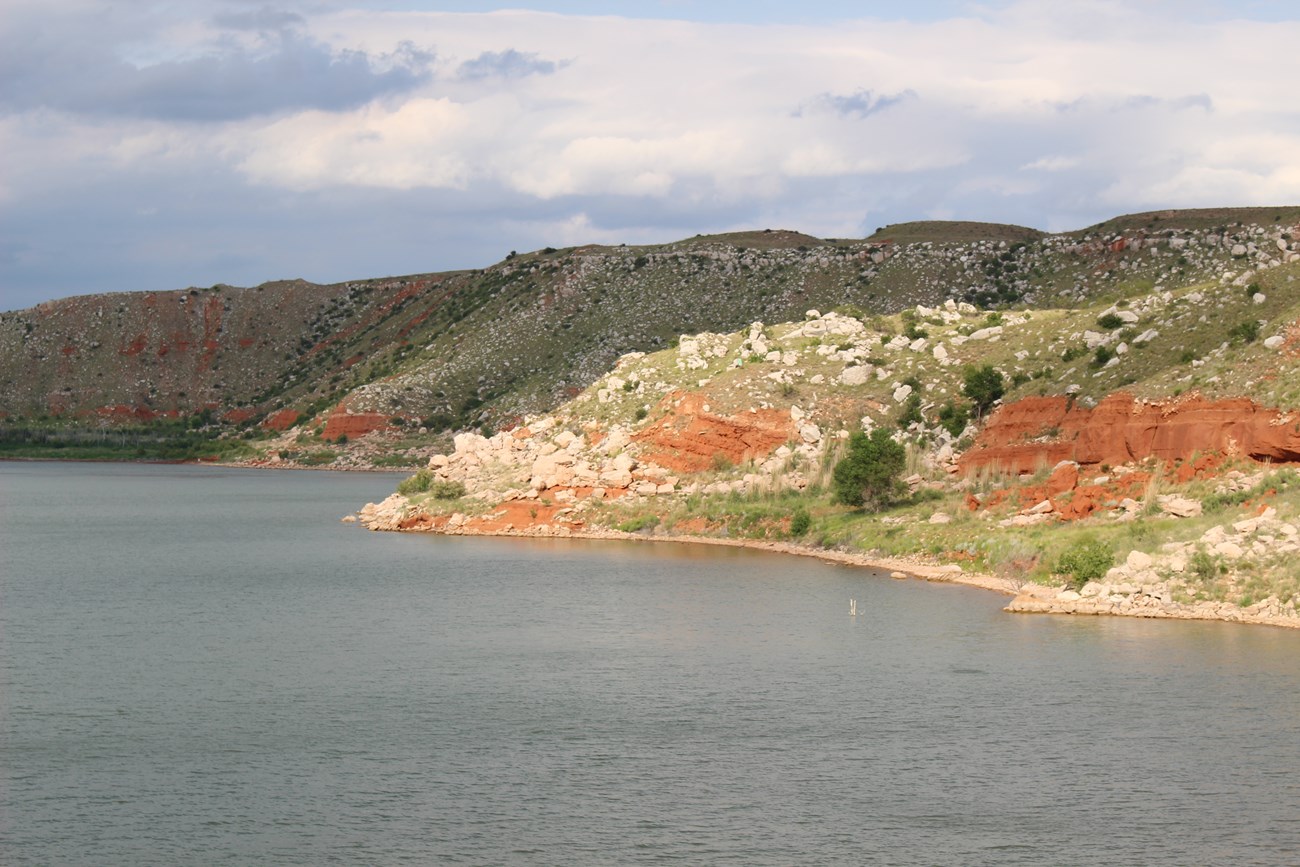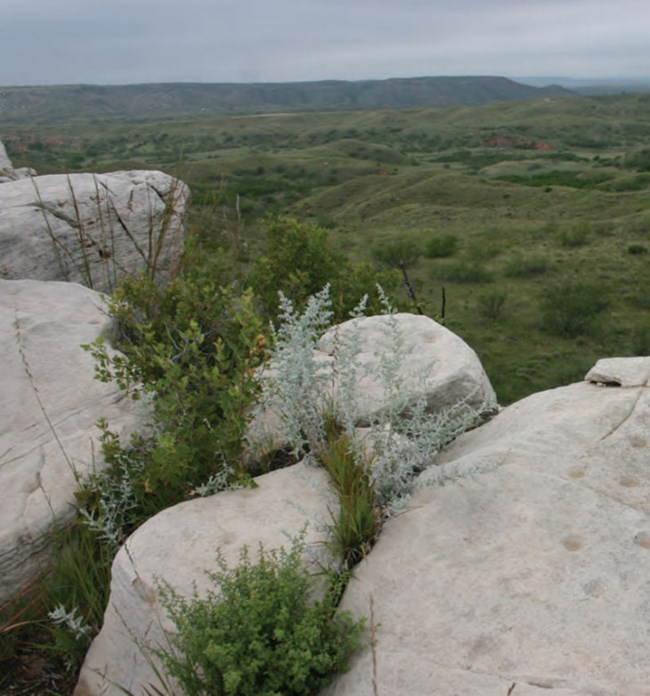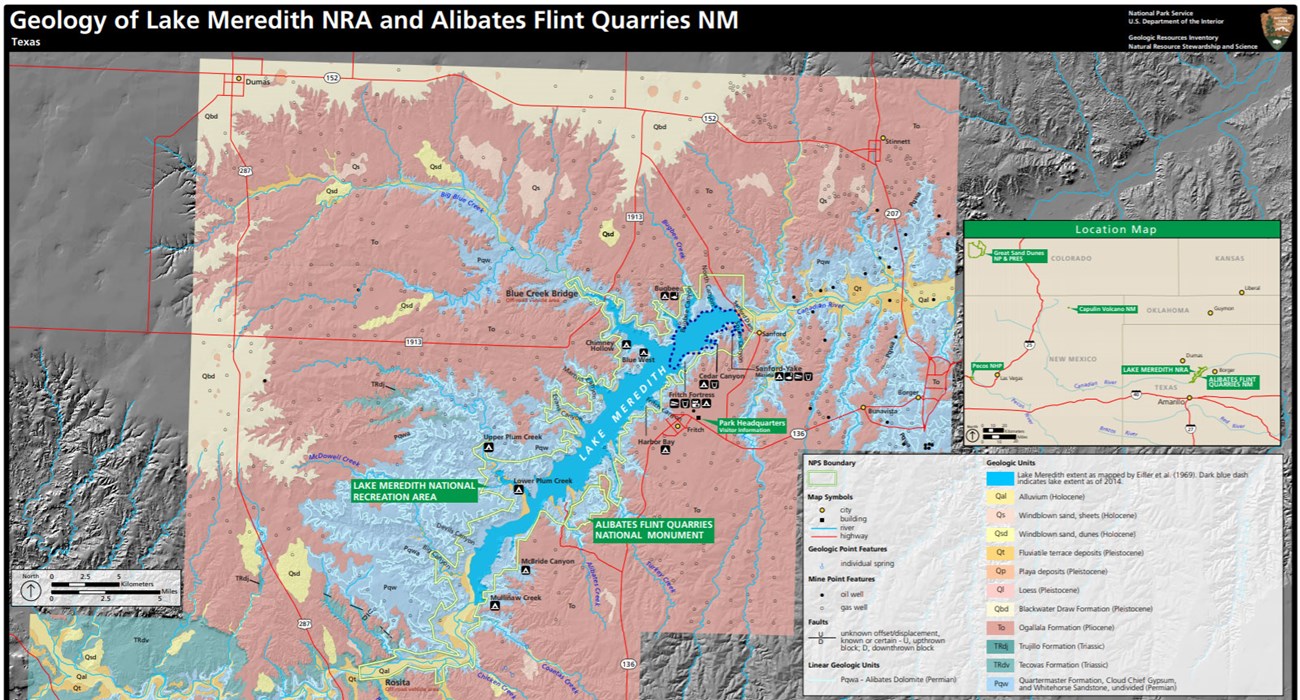Last updated: June 17, 2024
Article
NPS Geodiversity Atlas—Alibates Flint Quarries National Monument, Texas
Geodiversity refers to the full variety of natural geologic (rocks, minerals, sediments, fossils, landforms, and physical processes) and soil resources and processes that occur in the park. A product of the Geologic Resources Inventory, the NPS Geodiversity Atlas delivers information in support of education, Geoconservation, and integrated management of living (biotic) and non-living (abiotic) components of the ecosystem.

Introduction
Alibates Flint Quarries National Monument (NM) was established to preserve, protect, interpret, and study scientifically the Alibates flint deposits associated with the activities and cultural resources of indigenous peoples of the Texas Panhandle. Alibates Flint Quarries NM, at 1,371 acres in size, contains more than 700 flint quarries and other cultural sites that show evidence of 13,000 years of human occupation in the Canadian River valley. The monument is managed jointly with Lake Meredith National Recreation Area (NRA) with which it shares a border. In order to protect archeological sites and natural resources, access to the monument is limited to guided tours.
Geologic Features and Processes
Alibates Flint Quarries is within a surprising section of canyon landscape in the Canadian River valley below the Caprock Escarpment on the otherwise mostly flat High Plains of Texas. The Canadian River valley, also known as the Canadian Breaks, is the setting for Lake Meredith, the reservoir formed by the Sanford Dam.
Geologic features and processes identified in the park’s Geologic Resource Inventory include:
-
Geologic Structures
-
Permian Red Beds
-
Alibates Dolomite and Alibates Flint
-
Triassic Rocks
-
Ogallala Formation
-
Paleontological Resources
-
Dissolution of Red Beds
-
Karst
-
Rock Shelter
-
Canadian River
-
Canadian Breaks and Caprock Escarpment
-
Lake Meredith
-
Aeolian Features and Processes
Geologic Setting

Graphic by Jason Kenworthy (NPS Geologic Resources Division) after Gustavson and Finley (1985, figure 2). Base map by Tom Patterson (National Park Service).
The Canadian Breaks are a major physiographic feature that cuts across the Texas Panhandle. Situated below the Caprock Escarpment, the transition point between the relatively flat plains and the canyon landscape of the Canadian River valley, the Canadian Breaks divide the High Plains physiographic province into the Central High Plains to the north from the Southern High Plains. The Caprock Escarpment is a widespread erosional scarp topped by caliche zone in the upper part of the Ogallala Formation, which is as thick as 30 ft (9 m).
Older geologic structures controlled the deposition of Permian and Triassic sedimentary rocks exposed in Alibates Flint Quarries NM. The recreation area is located on top of the Amarillo uplift, a structural high between the Anadarko and Palo Duro basins. The Amarillo uplift is a buried mountain range that developed approximately 300 million years ago. The Amarillo uplift is buried by as much as 6,000 ft (1,800 m) of sediment and the Anadarko Basin, one of the deepest basins in the continental United States; is filled with approximately 40,000 ft (12,000 m) of sedimentary rock. The Palo Duro Basin contains about 10,000 ft (3,000 m) of sediment.
Alibates Flint

NPS photo.
Alibates flint has been highly prized by American Indians for thousands of years for use in stone tools. The quarries in the national monument are shallow pits where native peoples burrowed for unfractured, unweathered chert for use in tool manufacture. During their peak usage, the quarries were from 5 to 25 ft (1.5 to 7 m) across and about 4 to 8 ft (1.2 to 2.5 m) deep. The more than 700 quarries in the monument have since partially filled with windblown dust during the last 500 years so that they are now shallow depressions at least 6 ft (2 m) in diameter surrounded by waste piles of flint pieces.
Alibates flint comes from a 10-sq-mi (26-sq-km) area near Lake Meredith, but is concentrated in Alibates Flint Quarries NM. Alibates flint was a highly-prized stone for tool making that could hold a hard edge. Alibates flint was high demand along trading routes throughout North America. Projectile points and other tools made of Alibates flint have been found in sites across the Great Plains, the Southwest, as far north as Montana, and as far east as the Mississippi River.
Alibates flint occurs as lenses or nodules in the Alibates Dolomite. The Alibates Dolomite is a marine sedimentary rock approximately 15 feet thick (4.5 m) thick that has been mapped as a linear feature in both parks. Most exposures of Alibates Dolomite in the national monument yield Alibates flint. Alibates flint is a beautifully mottled or banded, multi-hued (red, pink, pale blue, pale purple, gray, brown, or black) form of chert. Chert consists of submicroscopic crystals of silica. The array of colors results from the presence of trace elements. The red, orange, and yellow colors are caused by iron; blues and deep greens are usually caused by manganese.
Flint is much more abundant in the Alibates’ upper dolomite layer, but it is not confined to any particular bed or stratigraphic horizon in the Alibates Dolomite. The lower dolomite layer generally contains minor amounts of flint in the form of spheres and nodules. Alibates flint formed via a process called certification, where silica (silicon dioxide, SiO2) replaces the original dolomite (calcium magnesium carbonate, CaMg(CaO3)2).
The source of silica for Alibates flint is unknown, but most likely came from overlying rocks. Potential source rocks of silica include Triassic rocks in the area that contain chert and petrified wood, the Tertiary Ogallala Formation, or volcanic ash.
Geologic History

NPS photo
Most of the colorful red and white rock layers (formations) exposed in Alibates Flint Quarries NM were deposited approximately 260 million years ago during the Permian Period when what is now the Texas Panhandle was located near the equator and was part of the supercontinent Pangaea.
These sandstones, siltstones and mudstones, along with interbedded layers of gypsum and dolomite, are collectively known as Permian red beds for their age and predominate red to orange hues. The Permian red beds were deposited near the margin of an arm of the sea that extended up from the south. Some of these sediments were deposited on coastal plains, others in marine basins and yet others in tidal flats. Massive amounts of salt and other evaporite minerals were included in these sediments that reach thousands of feet in thickness, mostly in the subsurface, with the greatest thickness south of the Lake Meredith region.
The Permian reds beds in Alibates Flint Quarries NM were mapped as an undivided unit that consists of three different formations, identified as the Whitehorse Sandstone, Cloud Chief Gypsum, and Quartermaster Formation. These formations are difficult to distinguish except by stratigraphic position, but at Alibates, stratigraphic markers are missing. Further, the nomenclature of Permian rocks in the Texas panhandle has a confusing history, making stratigraphic assignments complicated.
Red beds are colored by small amounts of iron oxides and clay minerals in them. The soft sandstones, siltstones and mudstones are easily eroded, making true outcrops of these rocks scarce. Instead, these rocks yield the rounded hills that make up much of the landscape in the Alibates area.
The Alibates Dolomite is one of the few easily recognizable strata within the red bed sequence. This thin off-white unit consists of upper and lower dolomite layers with a middle red bed, but in many areas, the upper dolomite has been removed by erosion. The dolomite was deposited under hypersaline marine conditions such as in mud flat environments while the red beds were deposited in a terrestrial environment. In places, evidence of algae mats is preserved in the Alibates Dolomite. In addition to being more resistant to erosion than the red beds and capping most of mesas and buttes adjacent to Lake Meredith, the Alibates Dolomite is also the source of Alibates flint.
The Tertiary Ogallala Formation directly overlies the Permian red beds, although Triassic sedimentary rocks are present in the southwestern part of Lake Meredith NRA.
The approximately 10-million-year-old Ogallala Formation is much younger than the underlying rocks, and sits atop a regional uncomformity, or period of missing time. The Ogallala Formation consists of materials shed from eroding mountainous areas to the west, and includes river, lake and wind deposits. The upper portion of the formation consists of caliche, a hardpan made up of calcium carbonate that forms in arid to semi-arid environments.
Landscape Evolution

NPS photo
After the deposition of the Ogallala Formation, the Canadian River carved its valley, which is as great as 40 miles (64 km) wide and 1,000 ft (300 m) deep, by incising into the caliche caprock within the last few million years. The Caprock Escarpment is the line of cliffs formed by the retreat of these cliffs through erosion into the canyons and broken country below.
The course of the Canadian River traces, at least in part, a broad zone of subsidence across the High Plains due to salt dissolution. Thick layers of salt and other evaporate minerals were precipitated in an enclosed arm of the sea prior to and at the same time that the red beds were deposited. Salt layers are susceptible to dissolution by groundwater and can cause collapse and subsidence of the overlying rock layers. The base of the Ogallala Formation in the collapse zone has subsided 300-600 ft (100-200 m) relative to other areas of the High Plains. The subsidence of the ground surface due to salt dissolution explains in part how the relatively small Canadian River carved such a large valley.
Much of the salt dissolution probably took place during the Pleistocene when the climate was significantly wetter. Subsurface salt dissolution is still occurring in the area as evidenced by the high saline levels in the Canadian River and the presence of sinkholes in the region.
Geologic Issues
The Permian and Pennsylvanian rocks in the Texas Panhandle are also host to oil and gas deposits, and a number of producing wells are located in and around Alibates Flint Quarries NM. Oil and gas operations in the parks are administered by an oil and gas management plan.
Cave and Karst
Most of Alibates Flint Quarries NM is evaporative karst. Salt (halite) and gypsum in the Permian red beds are susceptible to dissolution by groundwater. Dissolution within Permian strata results in the collapse of overlying units. Collapse chimneys are distinctive dissolution-related features found in the area. These chimneys are circular or elliptical in cross section and filled with collapse debris. Most chimneys are buried and only exposed in road cuts or bluffs, but some chimneys, stand in relief as the breccia infilling them are more resistant to erosion than the surrounding red beds.
All NPS cave resources are protected under the Federal Cave Resources Protection Act of 1988 (FCRPA)(16 U.S.C. § 4301 et seq.).
Also see, Evaluation Of Cave And Karst Programs And Issues At US National Parks http://www.nckri.org/about_nckri/investigations/NCKRI_RI4.pdf
Paleontological Resources
While fossils have not been found in the Permian red beds, a variety of fossils have been documented in and around Alibates Flint Quarries NM. The Alibates Dolomite contains layered algal mats or stromatolites. Algal mats form when algal filaments trap carbonate mud, usually in saline tidal flat environments. Reported fossils from the Ogallala Formation in or near Lake Meredith NRA include vertebrate, invertebrate and plant fossils.
All NPS fossil resources are protected under the Paleontological Resources Preservation Act of 2009 (Public Law 111-11, Title VI, Subtitle D; 16 U.S.C. §§ 470aaa - 470aaa-11).
Also see, Paleontological resources of Lake Meredith National Recreation Area and Alibates Flint Quarries National Monument, West Texas http://npshistory.com/publications/lamr/nmgsg-52-257.pdf
Geohazards
Natural geologic processes continue to shape the monument on time scales ranging from seconds to years, and visitors should be cautious and alert to geohazards that may be present.
Mass wasting, including rockfalls, creep, slumps and topples may occur on the slopes in Alibates Flint Quarries NM. Slope movements may occur on slopes made up of the Permian red beds, particularly below capstones made of the harder Alibates Dolomite. Boulders of the white Alibates Dolomite cascading down red hillslopes are one of the characteristic features of the area’s scenery. These boulders have fallen from the canyon rims and may travel further downslope.
Flash floods may occur in Alibates Creek and the many other tributaries that flow into Lake Meredith, presenting a potential geohazard.
The Texas Panhandle has a relatively low seismic hazard. The USGS 2014 Seismic Hazard Map indicates that the Alibates area has a 2% chance that an earthquake peak ground acceleration of between 10 and 14 %g (percent of gravity) being exceeded in 50 years due to natural earthquakes. Peak ground acceleration between 10 and 14 %g is roughly equivalent to VI on the Modified Mercalli Intensity Scale. The expected number of damaging earthquake shaking in the Texas Panhandle in 10,000 years is between 4 and 10.
Also see, USGS Earthquakes Hazard Program Information by Region-Texas https://earthquake.usgs.gov/earthquakes/byregion/texas.php
Regional Geology
Alibates Flint Quarries National Monument is a part of the Great Plains Physiographic Province and shares its geologic history and some characteristic geologic formations with a region that extends well beyond park boundaries.
Also see, Physiography of Texas http://www.beg.utexas.edu/UTopia/images/pagesizemaps/physiography.pdf
- Scoping summaries are records of scoping meetings where NPS staff and local geologists determined the park’s geologic mapping plan and what content should be included in the report.
- Digital geologic maps include files for viewing in GIS software, a guide to using the data, and a document with ancillary map information. Newer products also include data viewable in Google Earth and online map services.
- Reports use the maps to discuss the park’s setting and significance, notable geologic features and processes, geologic resource management issues, and geologic history.
- Posters are a static view of the GIS data in PDF format. Newer posters include aerial imagery or shaded relief and other park information. They are also included with the reports.
- Projects list basic information about the program and all products available for a park.
Source: NPS DataStore Saved Search 2676. To search for additional information, visit the NPS DataStore.
A NPS Soil Resources Inventory project has been completed for Alibates Flint Quarries National Monument and can be found on the NPS Data Store.
Source: NPS DataStore Saved Search 2703. To search for additional information, visit the NPS DataStore.


